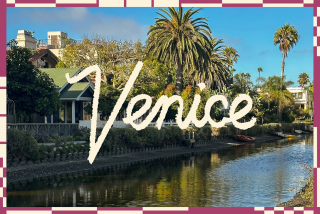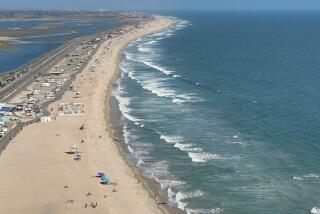The Sands of Time : Arnold Brothers Have Seen It All in Their Years at the Beach
- Share via
VENICE — No one has seen Venice like the Arnold brothers. Al and Arch Arnold have lived there for 170 years between them.
Only 82-year-old Al can claim full native status. Arch, 88, arrived six months after his birth in New York City. Their immigrant family (the boys’ father was Romanian, their mother French) left New York for California, taking the southern route through the Arizona Territories. Their intended destination was San Francisco, but while they were in Los Angeles a certain earthquake caused them and countless others to change their plans about living in the Bay Area.
So the Arnold family chose to stay in Venice, which had just opened--on the Fourth of July, 1905--as Venice of America, a city of canals and gondoliers fashioned after its Italian namesake. Meyer Arnold, Al and Arch’s father, ran a short-order food operation in downtown Los Angeles and rode the Pacific Electric Red Car back and forth to work.
Al was born in 1911 at their home at 4th and Indiana avenues in the Oakwood neighborhood of Venice, where the Arnolds lived until 1917, when they bought a house on Thornton Avenue. The brothers, both bachelors, live there still.
Arch stayed home most of the time; he made a career as a real estate broker and mortgage banker. Al toured the world as a merchant mariner, but kept coming back.
“I knew Venice was the best place in the world, so I didn’t have to go anywhere,” Arch said.
“I wanted to make sure, so I went around the world,” Al said.
What was life like in Venice, back in the early days when it was a city? Sitting on their favorite Boardwalk bench one day recently, eating ice cream and watching the tourists, they reminisced.
“Venice was the fun zone for all Southern California,” Al said.
“Everybody came to Venice to have a good time,” Arch added. “They came from all over the United States, even from Europe. There was Venice Pier, Sunset Ballroom, roller coaster rides, Ocean Park’s two amusement piers.”
On summer weekends or the Fourth of July, sometimes 30,000 people--equal to a tenth of Los Angeles’ population--came to Venice on the Red Cars.
“Every three minutes a three-car train would arrive,” Al said. “They’d jump out the windows before the train stopped, they were so ready to have a good time.”
“You know,” Arch said, “the beach was a lot narrower then.” When the Hyperion sewage plant was built in the 1950s, he explained, sand was pumped from the construction site to Venice Beach through a huge pipeline.
“The expanded beach keeps the oceanfront homes dry during big storms,” Al said. “I remember John Harrah’s home on Sunset Avenue almost got flooded.” This, he added, was the same Harrah family whose Venice Bingo Parlour worked so well that they moved to Reno to get into the big-time casino business.
Among Al’s early playmates were Helen and Clan Kinney, children of Venice founder Abbot Kinney. “Old Man Kinney, I gotta tell you, looked just like he does in the 1940 mural Ed Biberman painted inside the Venice Post Office,” Al said.
What did kids do for money in those days?
“We did anything for a buck,” Al said. “We used to dive off the Venice Pier at high tide for coins, not pennies, and make $10 to $11 a day.”
“Remember,” Arch said, “we used to work for the beach umbrella man, Gene Rittenhouse, who rented umbrellas for 25 cents a day. We’d carry the umbrella for people and plant it in the sand for a tip. At the end of the day, Gene paid us, I believe, 5 cents an hour to pick up the umbrellas off the beach.”
“We used to sell papers at 6 in the morning before school,” Al added. “We’d hop the Red Car going up Pacific--it was Trolley Way in those days--and sell papers to the passengers and then hop off in Ocean Park to catch the Red Car going south.”
“We had the best corner,” Al said. “Windward and Trolley Way. On a Saturday night, along The Promenade, we’d sell 500 papers. We made a penny a paper. The Examiner was the big seller in those days.”
So what are the biggest changes the brothers have seen in 82 years?
“A lot,” Al said. “The beach is a lot cooler. It used to be so hot they grew watermelon east of Lincoln Boulevard.”
“And there are less fish in the bay,” Arch added. “Our father used to bring home a sack of fish, croakers, just from fishing along the shore.”
“And women’s bathing suits have really changed,” Al said with a big smile. “In the early days women wore dresses. Men even had to wear a shirt or you’d be arrested for indecent exposure. Then along came the bikini, and now they just wear dental floss.”
Arch graduated from UC Berkeley in 1926. He did his first two years of undergraduate study at a place then known as the Southern Branch of the University of California, which soon afterward took the name UCLA and moved from North Vermont Avenue (where Los Angeles City College is today) to Westwood. He handles the brothers’ finances and laughed about changes in the cost of living.
“When I graduated from college I went to work for Southern California Edison at $150 a month, and that was a good job. . . . You know, there were no taxes in those days.”
“In those days,” Al said, “you couldn’t carry home a dollar’s worth of groceries.”
Do the Arnold brothers have any words of wisdom for the youth of today?
“Our mother,” Arch recalled, “used to say, ‘Whatever you make, save half of it because it may rain tomorrow.’ ”
Al remembered it a little differently: “Mom used to say, ‘Money doesn’t grow on trees, especially palm trees.’ ”
More to Read
Sign up for The Wild
We’ll help you find the best places to hike, bike and run, as well as the perfect silent spots for meditation and yoga.
You may occasionally receive promotional content from the Los Angeles Times.






